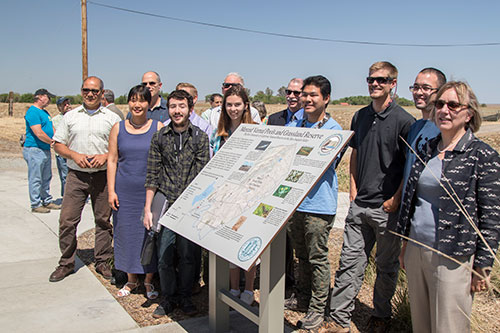
 Research, teaching and public outreach were all on display today at UC Merced’s celebration of the University of California Natural Reserve System’s 50th anniversary.
Research, teaching and public outreach were all on display today at UC Merced’s celebration of the University of California Natural Reserve System’s 50th anniversary.
The inaugural celebration of the 39-reserve system’s golden anniversary featured a driving tour of the Merced Vernal Pools and Grassland Reserve, which covers nearly 7,000 preserved acres adjacent to campus.
Led by reserve Manager Chris Swarth, the guided tour stopped along the way so visitors from the community, the campus and the UC could see landmarks such as the cliff swallow nests at Black Rascal Creek, the stock ponds that serve as ecosystems for many animals — including the endangered California tiger salamander — and just a few of the more than 100 birds that call the reserve home for all or part of each year.
More than 80 people turned out for UC Natural Reserve System (NRS) Day at UC Merced, including faculty members, local naturalists and vernal pool experts, students from the Yosemite Leadership Program, and researchers from other UC campuses.
“I’ve been on a walking tour of the reserve, but I wanted to see how it looks at different times of the year,” Health Sciences Research Institute Executive Director Trevor Hirst said.
Natural Reserve System's Newest Member
The vernal pools reserve is the newest member of the UC NRS, and the first San Joaquin Valley reserve to join the more than 750,000 acres the NRS protects and curates statewide.
Researchers at NRS Day shared their knowledge with the tour groups along the way and talked about the projects they are conducting there, including local ornithologist Steve Simmons, who has studied certain types of nesting birds for more than 40 years.
Simmons is working with graduate student Joy McDermot to study the dietary habits of the American kestrel. They’ve installed nesting boxes around the reserve and are trying to determine why kestrel populations are declining across the country despite the increasing use of nesting boxes to offer the birds safe places to hatch and raise their young.
 Niall McCarten, a researcher from UC Davis, joined the tour as well, and talked about his soil-sensor project on the reserve lands. He’s studying soils and climates that are unique to this area.
Niall McCarten, a researcher from UC Davis, joined the tour as well, and talked about his soil-sensor project on the reserve lands. He’s studying soils and climates that are unique to this area.
At the reserve’s entrance, UC Merced Vice Chancellor for Research and Economic Development Sam Traina unveiled a new interpretive sign that introduces visitors to some of the key features and inhabitants of the reserve.
Engineering Service Learning students on the Vernal Pools Reserve team spent the past two semesters researching, fact-checking, writing and designing the sign that now stands beside the reserve’s main gate on Ranchers Road.
“We worked to identify the most important species on the reserve,” student Daniel Toews said. “We wanted to include keystone, rare and endangered species, plus maps so visitors can see some of the land’s key features, landmarks and topography.”
“This sign is the first piece of infrastructure associated with the reserve,” Traina said, “although we hope for many more.”
Contributions to Education and Research
Swarth has said he’d love to see a visitor center and perhaps a raised walkway through the reserve, so people can visit without damaging the ancient soils and fragile ecosystems on the land.
“We want to educate people about the reserve and the NRS, the natural history of the land and the organisms that live on it, and the importance of the vernal pools,” Swarth said.
Part of that education will come from the results of research projects like the four being conducted by graduate students who received grants from the reserve to further their studies. Besides McDermot’s kestrel project, Brandon Stark uses unmanned aerial vehicles to map the whole property using regular and infrared cameras to help evaluate topography and ecosystems, Erin Babich studies the monkey flower to see how it adapts to climate change, and Eric Williams examines the reserve’s small mammal population.
The research being conducted on the reserve is emblematic of UC Merced, reserve Director Professor Martha Conklin said.
“It’s really impressive to have engineers, biologists and ecologists all working on the same land, and working together on their research,” she said.
Lorena Anderson

Senior Writer and Public Information Representative
Office: (209) 228-4406
Mobile: (209) 201-6255






